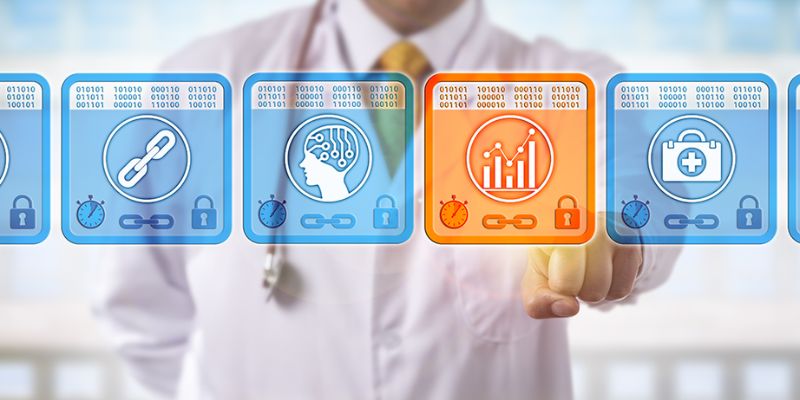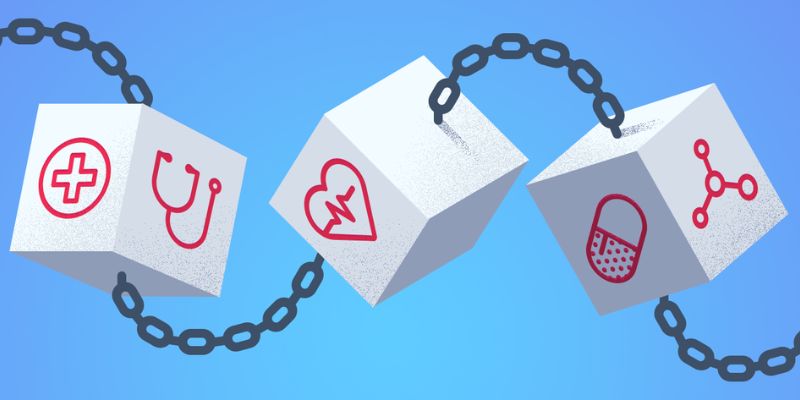Challenges of Blockchain in Healthcare: Navigating the Hurdles for Better Patient Care
Imagine a health system safe from hacks, where your private medical history stays rock-solid secure. That’s the dream of blockchain in healthcare. But it’s not all smooth sailing. Tackling challenges of blockchain in healthcare is like facing a tough boss in a video game: hard but not impossible. Hospitals want it, patients could love it, yet big puzzles remain. From keeping your info private to fitting within the health world’s strict rules, we’ve got to map this tricky terrain. Stay with me as we explore these tough spots, aiming for a finish line where your health care comes with peace of mind and iron-clad security.
Understanding the Landscape of Blockchain Technology in Healthcare
Analyzing the Current State of Healthcare Data Security
Right now, keeping health data safe is a big worry. Every day, we hear about data theft and illegal system access. It’s not just about losing data. It’s about trust. People count on us to keep their health info safe.
But cracks show up, despite our best efforts. Hackers find ways to break in. They steal personal data. This can lead to harm and a loss of faith in the system.
So, what do we do? We look to blockchain technology in healthcare. It can help lock down our info. Picture a vault that makes sure each piece of data stays safe from theft. That’s blockchain.
With blockchain, we lay out a map of who can see what data. Only the right eyes see your health records. Blockchain makes this map almost impossible to change by any wrong hands.
In simple terms, data security with blockchain is like giving each bit of info a bodyguard. No one gets to the info unless they have the right pass. So nurses, doctors, and you can feel safe.
Addressing Patient Privacy Concerns with Blockchain Solutions
Patient privacy is like a promise. We tell you, “Your secrets are safe with us.” And you trust us to keep that promise.
But today’s tech can make it hard to keep that promise. Patient data can be seen, and sometimes used, in wrong ways. This scares patients. They don’t want their personal info spread around.
Here’s where the blockchain steps in. It helps us keep that promise. It protects patient info like a shield. Each patient has a key. Without that key, no one gets in to see their records. Simple and safe.
With blockchain, patient privacy isn’t a worry. It’s a guarantee. No one gets a peek at your records without you saying so. You hold the key. So, if your doctor needs to know something, you give a nod, and they see it. If someone else comes snooping? Sorry, the door’s locked.
Building a system on blockchain, we can track who’s asking to look at data. This way, we know who’s walking through those health info halls. And if someone shouldn’t be there? We know right away.
Mostly, blockchain brings trust back to healthcare. You know your data’s locked down. You know you’re the one holding the keys. And you know your secrets are safe with us.
That trust is what keeps healthcare going. When that trust gets stronger, we all win. Blockchain’s our way to fight back against data thieves. It’s our way to keep our health info safe and sound. And it’s our way to make sure that when we say your privacy’s safe, you can count on it.
Evaluating Interoperability and Compliance Challenges
Exploring Interoperability within Healthcare Blockchain Networks
Healthcare is complex. Many systems must talk to each other to work well. This is interoperability. Blockchain can help. It lets systems share healthcare data securely. But it’s hard to make them work together. Why? Each system is different. They have their own rules for data. They don’t talk the same language.
What’s the fix? First, we find common ground. We look at existing tech. How do they share info now? We build on that. Blockchain application in healthcare must fit in smoothly. It must make data sharing easier, not harder. We want patient info to flow without hassle. So doctors have what they need, when they need it.
Now, let’s talk patient privacy and blockchain. With blockchain, data is split. It’s stored across a network. This makes sure no one sees a patient’s info without permission. It’s like giving a puzzle to a group. Each person has one piece. No one sees the whole picture. It’s safe. But, we must be sure patient details stay private. Each blockchain bit must keep secrets.
Interoperability with healthcare blockchain isn’t simple. How do we handle this? We use smart contracts. They are rules written in code. They manage data in blockchain. They say who can see what, and when. This helps lock down patient info. It makes sure only the right eyes see it.
We’ve seen data breaches shake trust. Patients worry about their details. Blockchain can help. It’s like a rock. Once you add data, it’s hard to change. This keeps healthcare data security solid. If we use blockchain well, trust grows.
Navigating Regulatory Compliance in Blockchain Implementations
Regulations are like a big rule book for healthcare. They’re strict. For a good reason. They protect patients. They make sure data doesn’t fall into wrong hands. Health laws like HIPAA set these rules. They tell us how to handle personal health info.
Blockchain must fit these laws. This is regulatory compliance blockchain must follow. Every bit of tech we use must play by the rules. But blockchain is new. The rule book doesn’t talk about it much yet. We have to be smart. We have to guess how to fit blockchain in. And we must always think about patient safety.
Cost is a big thing too. Implementing blockchain in healthcare isn’t cheap. We need computers, servers, and smart people to run it. These all cost money. But remember, if we do it right, it can save money later. No wasted time on mishandled data. No big fines for broken rules.
Lastly, education matters. Healthcare folks need to know blockchain. They need training. This way, they’ll use blockchain right. It keeps everything running smoothly. When people know what they’re doing, they’re not scared of change. They’ll try new things.
Blockchain can make healthcare better, I believe it. We just need to know how to put the puzzle pieces together. It’s about secure data sharing, keeping patient info private, and following the rules. Let’s work together to get it right.
Assessing the Impact of Blockchain Adoption Barriers
Identifying Scalability Issues in Blockchain Infrastructure
When we bring blockchain into healthcare, we must think big. Yet, big ideas hit roadblocks. Scalability is one such roadblock. What is it, you may ask? It’s a way to measure if blockchain can handle lots of work without faltering. When more people and hospitals join, can our blockchain keep up? Right now, it often can’t. Why? Because each piece of data must get agreement from all blockchain parts. This takes time and power.
We use blockchain to make healthcare data safe. It helps keep personal patient info private. Blockchain does its job well, but can struggle when lots of data come its way. I’ve seen it. It drags its feet – like a snail in a race with too many hurdles. We need it to sprint. To do this, we need smarter systems. Ones that can handle big loads without breaking a sweat.
Considering the Costs and Technical Complexities of Implementation
Let’s talk money and tech – both big topics. But we can’t ignore them. Launching a blockchain in healthcare isn’t simple or cheap. We need to build everything from scratch. Think of it like building a rocket. You need parts, people who know how to put it together, and fuel to launch it. And all of this costs a lot.
Tech stuff also gets tricky. Not everyone knows how to set up blockchain stuff. It’s new, like learning to ride a bike for the first time. There are chains, ledgers, smart contracts – it’s a whole new language. And learning takes time. That’s why some doctors and health pros hold back. They need to see it’s worth their effort first.
And let’s not forget the laws. Yep, healthcare has tons of rules. We call it regulatory compliance. Blockchain must follow these rules too, like keeping patient data super safe. And when we change anything, we must check all those rules again.
Lastly, can we trust the tech? Will it keep our secrets? With so many cyber bullies around, we have to be sure. So, we test and retest to build that trust. With patient info on the line, we can’t take chances.
In short, we’ve got some climbing to do. We’re like hikers facing a steep hill. But, hey, the view from the top? Worth it. We see a future where data flows like a clear stream, and docs can pull up your health info with a click. A future where your secrets stay safe, and health pros work hand-in-hand, smoothly. That’s why I’m here, breaking down these barriers, one by one. For better care, for all.
Looking Toward the Future of Blockchain in Healthcare
Developing Strategies for Physician and Stakeholder Acceptance
Getting doctors on board with blockchain is tough. Why? They’re super busy. They care most about their patients. Adding in new tech must make sense. It’s got to be smooth and helpful for them. They need to see the good it does fast.
What is physician acceptance of blockchain in healthcare? It’s when doctors start to use blockchain as part of their work. They might be slow to trust it at first. Some don’t know a lot about this tech. That’s okay. Everyone starts somewhere.
We can show them how blockchain keeps patient info safe. We talk about how it makes sharing health records easy. They will like hearing about how it can save time. We have to make it clear. We have to keep it simple.
The idea is to make blockchain a tool they can’t work without. Like a stethoscope for their computer. Something that makes sense in their day-to-day jobs. First, we teach. Then we listen. We tweak the system until it fits their needs.
We also have to work with other people who help run health services. Like the folks who pay the bills and the ones who look at the law. They need to know how blockchain can save money and follow the rules.
We can build cool pilot projects. These are like test runs. They show how good things can be with blockchain. They let doctors and bosses see the real deal in action. It’s important that these test runs go smoothly. If they work well, it’s a win for everyone.
Strengthening Cybersecurity Measures to Prevent Data Breaches
Now let’s chat about keeping health info extra safe. Why? Because bad guys are always trying to get their hands on it. We want to stop them. How? With blockchain. This tech is awesome at guarding data. But like any castle, it needs strong walls.
What is a healthcare data breach? It’s when someone gets access to medical info they shouldn’t have. It’s bad news. People’s private stuff gets out. We don’t want that. So, blockchain steps in to help.
Blockchain makes each piece of data tough to mess with. It’s like a lock that only lets the right keys open it. So, if a bad guy gets in, they can’t change or take what they find. This keeps everything straight and honest.
But even blockchain can have weak spots. We have to watch out for these. We must keep up to date on the latest ways to make blockchain stronger. This means better ways to check who’s who. It means faster, cleaner ways to connect the data blocks.
We stand up to these challenges. We do it for the people whose stories are in those records. To keep them safe, we must never stop learning. We have to build teamwork. We have to work hard and be creative. That’s how we’ll make blockchain work best in healthcare. It’s a big job, but we’re up for it. Let’s make the future a place where health info is safe and sound for all.
We’ve walked through how blockchain can change healthcare, from keeping data safe to respecting patient privacy. We also saw how it can connect different parts of healthcare better and how we have to follow rules carefully when using it. Sure, it’s not easy. We know there are big challenges, like making it big enough for all people and figuring out the tech and costs. Still, if we plan well and get doctors and others on board, blockchain could make our health data safer than ever. It could be the future of how we share and keep our medical details safe. Thanks for sticking with this journey into blockchain and healthcare with me. Let’s keep our eyes on what’s next and be ready for a healthier, more secure tomorrow.


